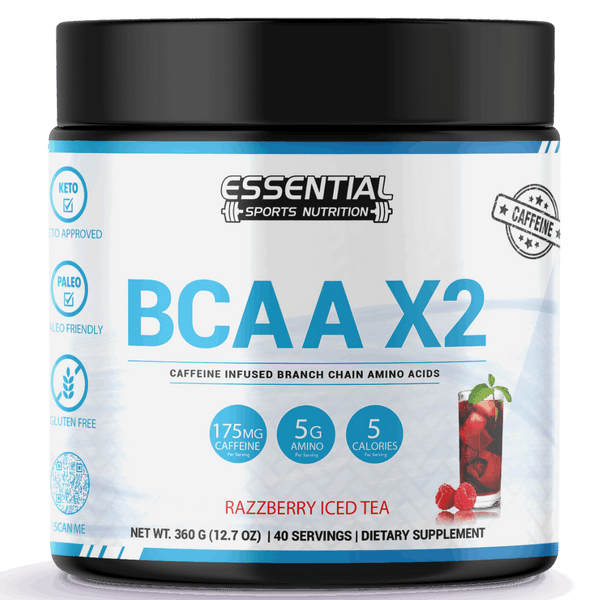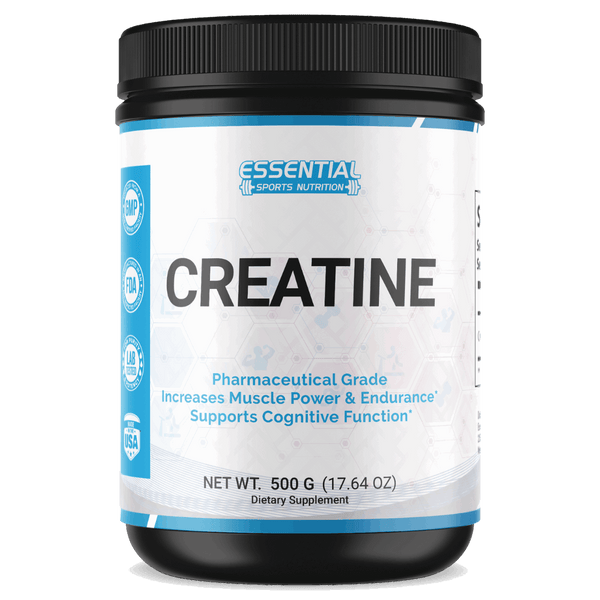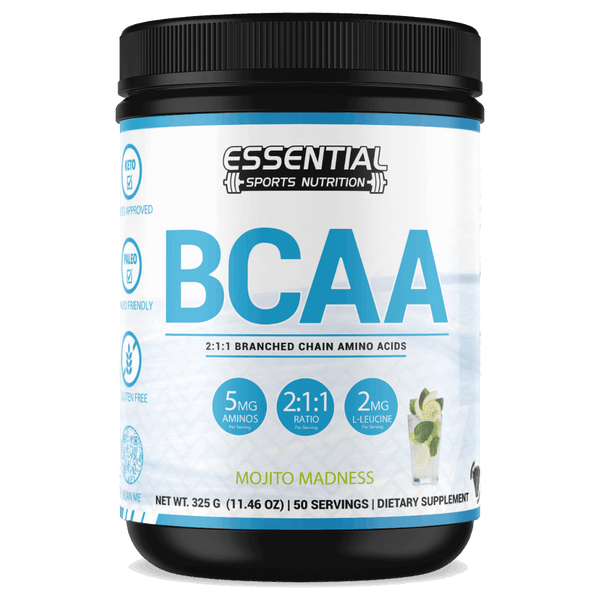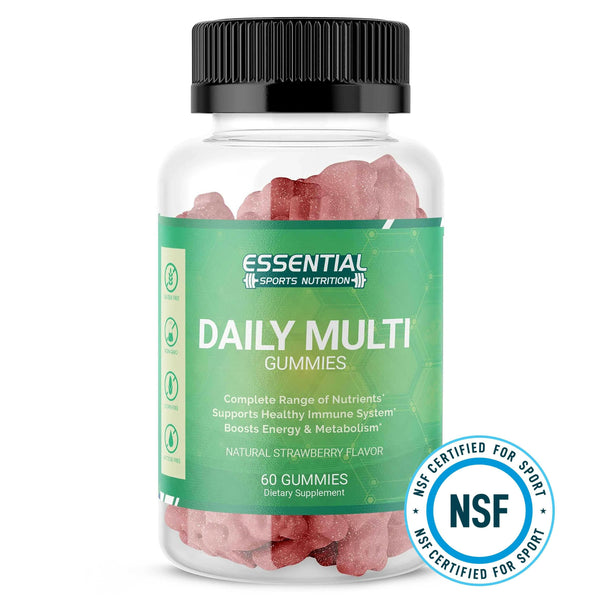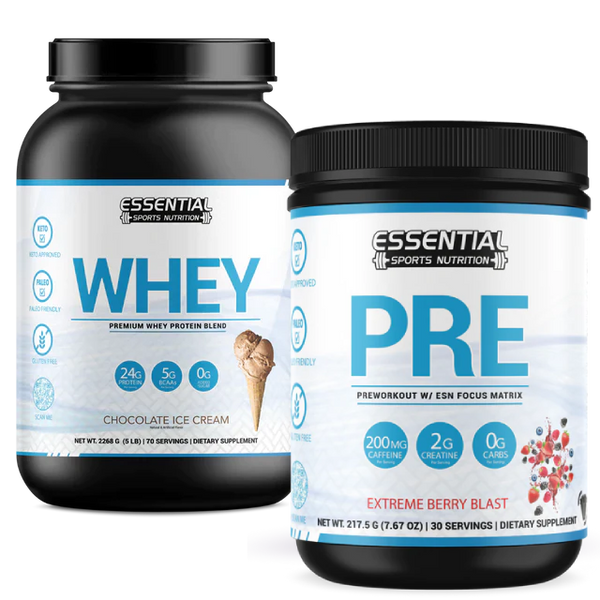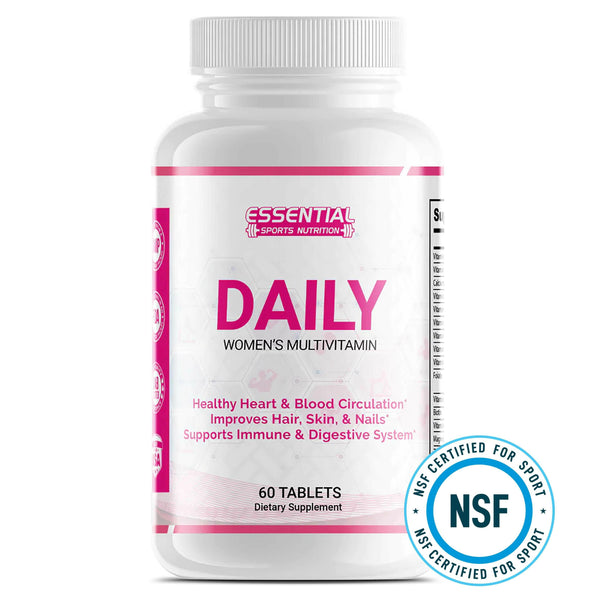Essential Amino Acids vs. BCAAs for Pre-Workout: What's the Difference?
As you dial in your pre-workout nutrition for that extra edge, understanding the unique roles of Essential Amino Acids (EAAs) and Branched-Chain Amino Acids (BCAAs) can be a game-changer in enhancing your gym performance. These powerhouse supplements have been put head-to-head in the conversation about optimizing pre-workout nutrition and ensuring effective muscle recovery and synthesis. In this deep dive, we look at how EAAs and BCAAs contribute to your muscle protein synthesis and the unique pre-workout benefits they offer, helping you make an informed choice to fuel your fitness journey.
Amino acids, both essential and branched-chain, serve as the vital building blocks that support your vigor during workouts and aid in the critical task of muscle recovery. Do EAAs or BCAAs better harmonize with your fitness goals? Whether supplementing with these amino acid powerhouses or focusing on pre-workout amino acids for an invigorated training session, the clues to muscle success lie in their intricate balance and your body's needs.

Key Takeaways
-
EAAs are vital nutrients your body cannot synthesize, making them key supplements for pre-workout nutrition.
-
BCAAs, specifically leucine, isoleucine, and valine, are crucial for rapid muscle recovery and reducing soreness.
-
Supplementing with EAAs and BCAAs supports muscle protein synthesis, which is essential for muscle growth.
-
Understanding the distinct roles of EAAs and BCAAs can help you tailor your supplement regimen to optimize workout outcomes.
-
Both EAAs and BCAAs have their unique advantages, with the choice between them depending on your specific training and recovery needs.
Understanding Amino Acid Supplements and Protein Synthesis

Exploring the world of fitness and health, you'll quickly unearth the significance of amino acids as both a nutrient powerhouse and a biological necessity, especially to enhance muscle health and recovery. It's fascinating how these organic compounds serve not just as the fundamental units that makeup proteins but also as a critical players in the process of protein synthesis, which is the body's method of repairing and building muscle tissue. In this segment, let's unpack the pivotal roles that amino acids play in nurturing and perpetuating muscle vitality.
The Role of Amino Acids in Muscle Health
Imagine the body's muscles as a complex architecture, consistently under construction, with amino acids being the key building blocks. Including the renowned Essential Amino Acids (EAAs) and Branched-Chain Amino Acids (BCAAs), they provide the scaffolding required for the construction—aka muscle protein synthesis. While EAAs are crucial for overall body function, touching aspects like energy, mood regulation, and even the digestive and immune systems, BCAAs are the sprinters in the marathon of fitness, helping you build muscle while efficiently managing muscle recovery post-exercise.
How Protein Synthesis Fuels Muscle Recovery
After a strenuous workout, your body is in a race against time to repair and fortify muscle fibers. This is where protein synthesis enters the fray, fueled by an ample supply of amino acids to not only expedite recovery but also to encourage the development of more robust muscle tissue. This process ensures that your efforts at the gym translate into visible and palpable gains, contributing significantly to your overall muscle health and aiding in creating a more resilient and better-sculpted physique.
Now, brace yourself for an in-depth exploration of the different amino acids that champion your journey to peak physical form:
| Amino Acid | Role in Muscle Health | Benefit During Recovery |
|---|---|---|
| Leucine | Primarily ignites muscle protein synthesis | Accelerates tissue repair and growth post-exercise |
| Isoleucine | Supports energy uptake and regulates blood sugar | Promotes endurance and speeds up recovery |
| Valine | Plays a role in stress management and immune function | Reduces muscle soreness and helps restore muscle function |
| Histidine | Important for tissue repair and the production of blood cells | Aids in recovery by boosting regeneration processes |
| Tryptophan | Maintains proper nitrogen balance | Contributes to recovery by reducing stress and fatigue levels |
The Science of Pre-Workout Nutrition

Before you hit the gym, the food you fuel up with is pivotal to ensure you have the energy, endurance, and performance necessary to maximize your workout. But it's not just about eating anything; it's about focusing on pre-workout nutrition that provides key nutrients for pre-workout that can enhance your ability to train harder and longer. Understanding these nutrients and how they work can help you optimize your pre-workout meals for peak results.
Optimizing Pre-Workout Meals for Maximum Performance
To prepare your body for a strenuous workout, you must think about pre-workout meals that are designed to provide a steady supply of energy while avoiding any discomfort during the exercise. The goal is to find the perfect balance between eating for comfort and eating for performance. Carbohydrates are your primary source of fuel, but they should be carefully selected. Complex carbohydrates such as whole grains provide long-lasting energy, while simple sugars can offer an immediate, albeit more short-lived, energy boost.
Key Nutrients for Energy and Endurance
When it comes to key nutrients for pre-workout, protein also plays a critical role. Including a moderate amount of lean protein in your pre-workout meal can aid in muscle function and recovery without weighing you down. Amino acids, specifically branched-chain amino acids (BCAAs), are worth considering too, as they can provide energy directly to muscle tissue. Combined, these nutrients work together to help increase your endurance and improve your overall performance.
A well-structured pre-workout meal not only powers you through a tough session but can also impact muscle soreness and recovery. Ingesting EAA and BCAA supplements has been shown to support muscle synthesis which is crucial for recovery, essentially allowing you to bounce back faster after a workout.
Essential Amino Acids (EAAs): Foundation for Muscle Growth

Understanding the role of essential amino acids (EAAs) in promoting muscle growth and ensuring optimal health is crucial for anyone looking to enhance their physical performance. EAAs are not just the building blocks of protein; they are the bedrock of robust health. Muscle protein synthesis, the process your body relies on to repair and build muscle fibers, hinges on the availability of these vital nutrients.
Nine EAAs Essential for Optimal Health
The nine EAAs required by the human body are histidine, isoleucine, leucine, lysine, methionine, phenylalanine, threonine, tryptophan, and valine. Without them, your body would struggle to perform essential functions such as hormone synthesis, digestion, and more crucially, repairing tissue damage and building muscle. As EAAs are not produced naturally, they must be sourced from your diet or supplements, a fact that underscores their importance in pre-workout nutrition.
How EAAs Drive Muscle Protein Synthesis
Muscle protein synthesis is your muscle's way of adapting and growing stronger in response to exercise. This intricate process relies on the adequate intake of EAAs. Each EAA plays a unique role in this complex biochemical process, facilitating the growth of muscle mass and speeding up recovery. For anyone from the dedicated athlete to the weekend warrior, the strategic consumption of EAAs can be the key to unlocking new levels of muscle growth and achieving optimal health. By incorporating EAA supplements into your pre-workout routine, you effectively set the stage for maximal performance and gains.
Taking BCAAs: Specialized Amino Acids for Workout Efficiency

When you dive into the world of fitness and nutrition, one term you’ll frequently encounter is Branched-Chain Amino Acids, or BCAAs. These powerhouse nutrients are more than just a supplement; they’re a key component of your muscle fuel and repair system. Understanding the benefits of BCAAs can significantly enhance your workout efficiency, making each session more effective.
BCAAs are made up of three amino acids: leucine, isoleucine, and valine. Unlike other essential amino acids, BCAAs are metabolized within the muscle tissue, allowing them to act quickly as an energy source during stress conditions, such as during a workout. Their ability to act as a direct muscle fuel can be a game-changer for your training routine.
By harnessing the power of BCAAs, you're not just feeding your muscles; you're creating an optimal environment for them to grow and repair.
Let's look at the roles of each BCAA:
-
Leucine: Often hailed as the 'main' BCAA, leucine plays a significant role in protein synthesis and muscle repair. It's like the foreman at a construction site, overseeing the rebuilding of your muscles post-workout.
-
Isoleucine: This BCAA is crucial in hemoglobin production and regulating blood sugar levels, thus providing you with the stamina needed for a lengthy workout session.
-
Valine: Though it plays a supporting role, valine is still vital for muscle growth and tissue repair. Think of it as the assistant to leucine, helping facilitate the muscle repair process.
The benefits of taking BCAAs include:
-
Enhanced muscle recovery: Accelerate the healing of muscle fibers damaged during strenuous exercises.
-
Reduced soreness: Diminish the severity of delayed onset muscle soreness (DOMS) for quicker bounce-back.
-
Aiding in endurance: Serve as an energy source when your body's glucose levels deplete, enabling you to sustain longer workout periods.
Let's break down how BCAAs stack up in terms of workout performance:
| BCAA | Role in Muscle Health | Impact on Workout |
|---|---|---|
| Leucine | Stimulates muscle protein synthesis | Directs efficient muscle repair post-exercise |
| Isoleucine | Involved in hemoglobin production | Helps extend workout endurance |
| Valine | Supports muscle metabolism | Aids in muscle tissue repair |
Looking beyond the table, what's clear is that incorporating BCAAs can provide that extra edge for those looking to improve muscle recovery and bring efficiency to their workouts. Whether you’re a professional athlete or a fitness enthusiast, these branched-chain amino acids should not be overlooked as part of your athletic nutrition regimen.
Branched-Chain Amino Acids (BCAAs) and Their Pre-Workout Advantages

Embarking on your fitness journey, you have likely encountered BCAAs, a trio that has gained recognition for their compelling workout support. Beyond just enhancing muscle building, these amino acids offer a comprehensive range of advantages that resonate well with any workout regimen. Let's explore how leucine, isoleucine, and valine, often dubbed as the muscle-building staples, might just be the workout companions you were looking for.
The Three Muscular Aces: Leucine, Isoleucine, and Valine
Leucine, a heavyweight in the world of amino acids, is known for being a catalyst in muscle protein synthesis. The role it plays in your body's ability to build muscle post-exercise is well-documented and critical to your recovery process. The isoleucine component is your endurance enhancer — it assists in muscle tissue synthesis, boosts energy, and promotes a robust immune system. Lastly, valine, often considered the repair agent, not only helps in muscle repair but also underscores leucine and isoleucine's contributions to muscle growth.
BCAAs: Beyond Muscle Building
While BCAAs are predominantly associated with muscle building benefits, their efficacy extends into realms of workout support that might surprise you. These include immune system bolstering and enzymatic energy regulation, illustrating that BCAAs are indeed advantageous well beyond the gym walls.
| Amino Acid | Role in Muscle Metabolism | Additional Advantages |
|---|---|---|
| Leucine | Stimulates muscle protein synthesis | Promotes growth hormone release |
| Isoleucine | Supports muscle tissue synthesis, energy production | Supports immune function, glucose consumption |
| Valine | Facilitates muscle repair, growth | Contributes to energy and stress management |
The special chemical structure that BCAAs possess allows them to be swiftly absorbed into your muscles, presenting not just a source of energy but a formidable tool in workout recovery and performance enhancement. So whether you are aiming for muscle building or seeking comprehensive workout support, incorporating BCAAs into your pre-workout routine could be the game-changer in achieving your fitness aspirations.
Essential Amino Acids vs. BCAAs for Pre-Workout: Detailed Comparison

Understanding the nuances between Essential Amino Acids (EAAs) and Branched-Chain Amino Acids (BCAAs) can profoundly impact your fitness regime, particularly when it comes to pre-workout supplementation. Both EAAs and BCAAs can influence your muscle protein balance, but they do so in distinct ways that can cater to different workout needs.
EAAs include a spectrum of nine amino acids that are indispensable for a host of metabolic functions. When ingested before exercise, they contribute towards establishing a positive net protein balance, which can be pivotal for those aiming to build muscle. On the flip side, BCAAs, comprised of three specific EAAs – leucine, isoleucine, and valine – are crucial for their quick metabolism and their exclusive role in thwarting exercise-related muscle loss.
To facilitate your decision-making process, let's dive into a pre-workout comparison of EAAs and BCAAs:
| Supplement Type | Benefits | When to Use | Best For |
|---|---|---|---|
| Essential Amino Acids (EAAs) | Enhance muscle protein synthesis, maintain general health, support metabolic functions | Pre-workout to establish a protein-rich environment for muscles | Building overall muscle mass, enhancing endurance |
| Branched-Chain Amino Acids (BCAAs) | Quick energy source, prevent muscle breakdown, reduce soreness after training | Immediately before or during workouts for energy; post-workout for recovery | High-intensity training, quick recovery, preventing muscle fatigue |
While EAAs offer a broader spectrum of benefits that go beyond muscle protein, BCAAs are often singled out for their ability to reduce muscle soreness and enhance recovery time, making them vital for muscle loss prevention during and after an intense workout.
Remember, the type of amino acid supplementation you choose should align with your individual fitness goals and your body's needs during exercise. Whether you're focused on enhancing muscle mass, need quick energy to sustain your workout, or seeking to minimize post-exercise fatigue, there's a tailored solution in the form of EAAs or BCAAs to optimize your pre-workout routine.
Amino Acids for Exercise Performance: Timing and Dosage

Unlocking the full potential of amino acids for exercise performance hinges on two pivotal factors: timing and dosages. These elements can dramatically influence the efficacy of amino acids in boosting your workouts, recovery, and overall results. Let's delve into the specifics to optimize your pre-workout regimen.
Timing Your Amino Acid Intake for Enhanced Performance
When you dine on the amino acid timing strategy, the goal is to fuel your muscles precisely when they need it most. Typically, consuming BCAAs just before or during your sweat session provides an instantaneous surge of energy. This quick hit of amino acids helps stave off muscle fatigue and facilitates the building and repair of muscle tissue. On the flip side, EAAs taken pre-workout act as a marvel for muscle endurance, keeping tiredness at bay and allowing you to push your limits.
Optimal Dosages for Pre-Workout Amino Acids
At the crossroads of science, fitness goals, and personal dietary needs, lie the optimal dosages for amino acids. Tailoring your intake to align with these factors is crucial for maximizing exercise performance. Whether you favor BCAAs, EAAs, or a combination of both, working with a nutrition expert can help carve out the perfect plan for you. Below, find a convenient table to guide you on typical dosage suggestions:
| Amino Acid Type | Typical Dosage Range | Timing | Benefits |
|---|---|---|---|
| BCAAs | 5-10 grams | Immediately before/during workout | Quick energy, muscle recovery |
| EAAs | 6-12 grams | 15-30 minutes before workout* | Endurance, muscle fatigue delay |
*Consult with a nutritionist for precise timing tailored to your body's response and the intensity of your workout.
Natural Sources vs. Supplemental Amino Acids

Understanding the vital contribution of amino acids in fitness can optimize how you achieve your workout objectives. Whether you're drawing these compounds directly from natural sources or leveraging the concentrated power of supplemental amino acids, each approach plays a pivotal role in muscle development and recovery. Let's explore how to tailor your amino acid source to align with your fitness goals.
Getting Your Amino Acids from Whole Foods
Whole foods, rich in proteins, are among the most reliable ways to obtain amino acids from food. Animal products such as chicken, beef, eggs, and fish are packed with EAAs and BCAAs. However, not to be overlooked are the abundant plant-based options like soy, beans, nuts, and quinoa that also provide a solid amino acid profile, particularly valuable for those following vegetarian or vegan diets.
Choosing the Right Supplements for Your Fitness Goals
While whole foods are an excellent source of amino acids, they might not always meet the practical demands of your diet or lifestyle. That's when choosing supplements becomes essential. Whether you're aiming for muscle gain, fat loss, or enhanced endurance, supplements can provide the required quantities of amino acids in a convenient form. It's critical to select high-quality products from reputable brands to ensure purity and efficacy.
| Goal | Natural Source | Supplement Option |
|---|---|---|
| Muscle Gain | Chicken breast, Eggs | Whey protein enriched with BCAAs |
| Endurance | Salmon, Legumes | EAAs blend |
| Weight Management | Tuna, Cottage Cheese | BCAAs capsules |
| Vegetarian/Vegan | Quinoa, Tofu | Plant-based amino acid powders |
Ultimately, whether you get your amino acids from sumptuous steaks or a scoopful of powder, what matters most is that they align with your personal health considerations and fitness goals. By making informed choices between natural sources and supplemental amino acids, you can harness the complete potential of these powerful nutrients to fuel your fitness journey.
BCAAs and Muscle Recovery: The Recovery Edge

As you delve into the world of fitness and muscle conditioning, understanding the pivotal role of BCAAs in muscle recovery is essential. Branched-Chain Amino Acids are not simply a trendy supplement; they are a vital component in your toolkit for minimizing muscle breakdown and reducing soreness after intense workouts, giving you that much-desired recovery edge. Let's explore how incorporating BCAAs into your routine can propel your recovery process and safeguard your hard-earned gains.
BCAAs serve as the building blocks necessary to repair and rebuild muscle, drastically reducing recovery time and alleviating the suffering from delayed onset muscle soreness (DOMS).
When you challenge your muscles during a workout, you're essentially causing microscopic damage to the muscle fibers. It's the healing of these tiny tears, aided by BCAAs, that allows your muscles to grow back stronger. Interestingly, BCAAs are metabolized within the muscle itself, meaning their muscle-sparing properties are activated right at the source of exertion.
| Benefits of BCAA Supplementation | Impact on Muscle Recovery |
|---|---|
| Reduces Muscle Soreness | Diminishes DOMS for faster bounce-back |
| Decreases Muscle Breakdown | Preserves muscle fibers during strenuous exercises |
| Accelerates Repair Processes | Supports swift muscle tissue regeneration |
| Enhances Growth and Repair | Promotes muscle hypertrophy post-exercise |
With the ability to both expedite recovery time and reduce the severity of muscle soreness, BCAAs are not just beneficial; they're game-changing. Incorporating them into your regimen could mean the difference between struggling through a week of discomfort and getting back into the gym, feeling strong and ready for more. Take advantage of the recovery edge by giving your muscles the essential nutrients they need to rebound and grow.
Maximizing Muscle Retention with EAAs

When it comes to enhancing your fitness regimen, Essential Amino Acids (EAAs) are a non-negotiable pillar for maximizing muscle retention and achieving long-lasting health benefits. These powerhouse nutrients are vital for warding off the unwanted breakdown of muscle tissue, also known as catabolism, preventing catabolism, especially during periods of intense training or dietary limitations.
Preventing Catabolism: How EAAs Protect Muscle Tissue
Fueling your body with EAAs is akin to fortifying your muscles with a protective shield. They play a critical role in protecting muscle tissue from being consumed as an energy source during taxing exercises. This protection is the key to preventing catabolism, ensuring that your efforts in the gym are built upon a foundation of sustained muscle growth and repair.
EAAs for Long-Term Fitness and Health Benefits
But the impact of EAAs extends far beyond the gym walls. Incorporating an optimal balance of these essential nutrients contributes to the long-term fitness benefits that keep your body thriving. From facilitating hormone and neurotransmitter production to reinforcing your immune system, EAAs are champions of your overall well-being and an essential component of a health-focused lifestyle.
The Synergy of EAAs and BCAAs: Should You Combine Them?

When it comes to boosting your muscle growth and achieving a superior muscle protein balance, understanding the relationship between EAAs and BCAAs is critical. These amino acids, essential for various body functions, also hold the key to more effective workouts and muscle health. The question many fitness enthusiasts ask is about the benefits of combining EAAs and BCAAs in their supplementation routine. Let's explore this synergy further and how it can potentially elevate your fitness regimen.
BCAAs, mainly leucine, isoleucine, and valine, are renowned for their immediate stimulation of muscle protein synthesis. They accelerate the recovery phase, which is crucial after intense training sessions. However, they cannot sustain muscle protein synthesis alone. That's where EAAs come into play. Besides BCAAs, other EAAs are essential for prolonged protein synthesis and ongoing muscle repair and growth.
By combining EAAs and BCAAs, you provide your body with a comprehensive array of building blocks necessary for muscle protein synthesis. This duo works in harmony to support not just the initiation of the process, but also its duration and efficacy, leading to better muscle repair, growth, and overall muscle health.
Imagine EAAs and BCAAs as members of a relay team, where BCAAs kick-off muscle protein synthesis with power while EAAs carry it through to a sustained state of growth and maintenance.
The idea of combining these amino acids is not just about muscle growth—it's also about creating a balanced internal environment for muscle protein balance. This balance is vital for reducing muscle breakdown (catabolism) and promoting muscle preservation, especially if you're exercising in a fasted state or engaged in strenuous, prolonged activity.
Below is a table highlighting the unique attributes of both supplement classes:
| EAAs | BCAAs |
|---|---|
| Support overall bodily functions | Directly fuel muscle synthesis |
| Needed for prolonged protein synthesis | Rapid absorption for immediate use |
| Includes all nine essential amino acids | Consists of three key amino acids for muscles |
| Help maintain muscle protein balance | Reduce muscle soreness post-exercise |
Ultimately, whether you should combine EAAs with BCAAs may depend on your specific goals and the demands of your training routine. However, the synergy between the two can cater to both the immediate and enduring needs of muscle tissue during and after workouts, potentially optimizing your path towards muscle growth and health.
While BCAAs can provide a quick kickstart to muscle recovery, EAAs join forces to ensure the race is won with long-term muscle growth and optimal physical health. Consider consulting with a nutrition expert to personalize your supplementation approach, as the union of these amino acids could well be your secret weapon for achieving peak physical performance.
Conclusion

As you seek to optimize your training regimen, selecting the best pre-workout amino acids becomes a cornerstone for success. The choice to integrate EAAs, BCAAs, or a combination of both into your workout routine reflects a commitment to not only enhancing your physical output but also to fortifying your overall wellness. Essential Amino Acids (EAAs) offer an extensive array of health benefits that are foundational, while Branched-Chain Amino Acids (BCAAs) zero in on the intricacies of muscle recovery and energy metabolism during exercise.
Choosing the Best Pre-Workout Amino Acids for Your Training Regimen
You must weigh the nuances of each to determine their roles and efficacy in relation to your unique fitness objectives. While EAAs ensure a comprehensive coverage necessary for muscle building and maintaining bodily functions, BCAAs expedite muscle recovery, helping you bounce back faster after strenuous activity. Your dietary preferences, workout intensity, and personal goals will guide your choice in sourcing these amino acids, be it through whole foods or tailored supplements.
The Final Verdict on EAAs vs. BCAAs for Your Pre-Workout Routine
In making the final verdict in the EAAs vs. BCAAs debate, an informed approach is recommended. Employing both in your workout routine might be the ultimate strategy for sustained muscle development, restoration, and peak performance. As the evidence suggests, embracing the distinctive advantages of each - harnessing EAAs for a wide-reaching boost to health and utilizing BCAAs for targeted muscle metabolism - could very well result in the most efficacious fitness solution specific to your needs. Regardless, personal experimentation and adjusting based on outcomes could lead you to the ideal pre-workout amino acid protocol.
Differences Between EAAs and BCAAs FAQS
Q: What are the differences between essential amino acids (EAAs) and branched-chain amino acids (BCAAs)?
A: EAAs are a group of nine amino acids that the body cannot produce on its own and must be obtained from the diet or supplements. BCAAs, on the other hand, are a subgroup of three essential amino acids: leucine, isoleucine, and valine.
Q: What is the importance of EAAs and BCAAs for pre-workout supplementation?
A: Both EAAs and BCAAs play crucial roles in muscle protein synthesis, muscle recovery, and preventing muscle breakdown during intense workouts, making them valuable supplements for pre-workout use.
Q: Can I take EAAs and BCAAs together as part of my pre-workout supplement?
A: Yes, taking EAAs and BCAAs together can provide a comprehensive blend of essential and branched-chain amino acids, supporting various aspects of muscle growth, recovery, and performance during workouts.
Q: When should I take EAAs or BCAAs for optimal effectiveness?
A: It is beneficial to take EAAs or BCAAs before and during your workout to maximize their impact on muscle protein synthesis and reduce muscle fatigue and breakdown during intense training sessions.
Q: What is the significance of BCAAs alone versus supplementation with EAAs?
A: While BCAAs can provide specific benefits such as reducing muscle soreness and fatigue, supplementing with EAAs offers a more complete spectrum of essential amino acids, supporting overall muscle protein synthesis and recovery.
Q: How do BCAAs and EAAs contribute to muscle growth and recovery?
A: Both BCAAs and EAAs stimulate muscle protein synthesis, which is essential for muscle growth, repair, and recovery after workouts, helping to maintain and build lean muscle mass.
Q: Are BCAAs or EAAs considered essential amino acids?
A: While BCAAs are essential amino acids, EAAs encompass a broader group of nine amino acids, including the three BCAAs, all of which are crucial for various bodily functions.
Q: Can I benefit from supplementing with BCAAs alone, or should I consider essential amino acid supplementation?
A: While BCAAs offer specific benefits, supplementing with EAAs provides a more complete range of essential amino acids that can support a broader spectrum of bodily functions and muscle-related processes.
Q: How many grams of essential amino acids or BCAAs do I need for effective supplementation?
A: The optimal dosage of essential amino acids or BCAAs can vary based on individual factors such as body weight, fitness goals, and workout intensity, but typical recommendations range from 5 to 10 grams for effective supplementation.
Q: What are the potential benefits of supplementing with BCAAs or EAAs?
A: Both BCAAs and EAAs can provide benefits such as supporting muscle growth, reducing muscle soreness, enhancing exercise performance, and aiding in muscle recovery, making them valuable supplements for individuals engaged in regular physical activities and workouts.



